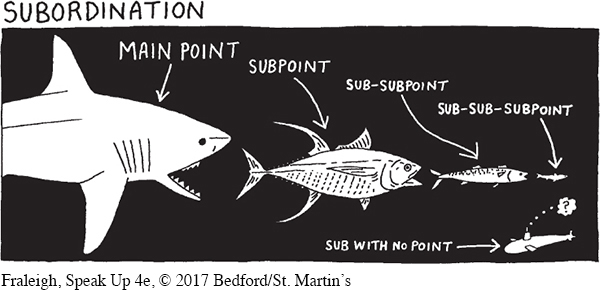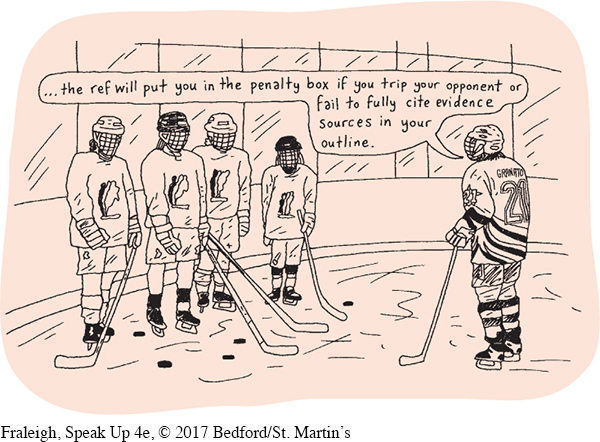Outlining the Body of Your Speech
You can think of the body of your speech as representing the “meat” of your presentation. In the body, you’ll present your main points and supporting materials (such as examples, stories, statistics, and testimony from experts). The body thus contains most of the content of your speech. Follow the practices listed in this section to outline the body of your speech effectively.
Use proper labeling and indentation. Start each main point at the left margin of your working outline, and indicate each new main point with a roman numeral. Indent each of your subpoints, and label them with capital letters. If you develop a subpoint further with two or more supporting ideas, indicate each of these sub-
311

Use full sentences or detailed phrases. In your working outline, you should express your main ideas, subpoints, and sub-
Check for subordination. In a well-
312
“This supports the point I am making because . . .”

If you can’t come up with a logical way to complete this sentence, you may need to reexamine your supporting materials and find ways to make them more clearly relevant. For example, you might want to move a subpoint to a place in your outline where the idea fits better. Or you may decide to reword a main point or subpoint so that the supporting material more clearly explains or expands the idea it is meant to support. Finally, you could consider developing a supporting example or explanation into a main point.

313
Include full information for citations, quotations, and other evidence. When you use evidence to support a claim, you need to include in your working outline all the information about the source of your evidence—the author, her or his qualifications, the source publication or Web page, and the date of publication. And if you are quoting a source, be sure to present the information word-
For example, here’s how you would outline evidence for a commemorative speech about Cammi Granato, one of the first two women elected to the Hockey Hall of Fame and a two-
Cammi Granato is a role model for young girls.
The Olympic gold medal was a catalyst. According to Barbara Ann Williams, a skating coach in the National Hockey League, in Positive Power, 2014, after the U.S. women’s team defeated Canada in the 1998 gold medal game, “little girls were now able to turn on their TV’s and see Cammi Granato, captain of the U.S. team, on Nike commercials with other famous athletes. These women had become our dream team and were the catalyst for the continued rise of interest in our sport.”

314
Insert transitions. As discussed in earlier chapters, a transition is a sentence that indicates you are moving from one part of your speech to another. Using transitions helps you keep on track and makes it easier for listeners to follow along. At minimum, include transitions
between the introduction and the body,
when you move from one main point to the next, and
between the body and the conclusion.
In your outline, indicate a transition by labeling it and placing it in brackets, as shown in the following example:
[TRANSITION We have considered the physical skills needed to become a Navy Seal; next, let’s turn our attention to mental abilities.]
To see the use of transitions and signposts in a speech, try Video Activity 11.1, “Roth, Emergency in the Emergency Room.”